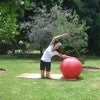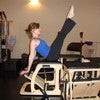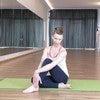Description
About This Video
Transcript
Read Full Transcript
Hi, I'm Zoe trap peak, the laddies master trainer and program director and with me is Connie Bordeaux peak [inaudible] and leadership team member. We're excited to share with you today the idea of how the eyes impact movement of the spine. I've been told by many of the elders that Joe was really demanding that the ice state open when we do philosophies and that tradition lives on in classical plots today, but have you ever wondered why? I've wondered why and I looking back with my knowledge that I have and that people have graciously shared with me, we know he was a genius of the body and I believe in my heart that he could see how I movement and I focus impacted, especially movements of the spine. Personally, Connie and I both struggled with neck issues and for me, my neck issues stemmed all the way back into my twenties I've had whiplash five times and I went to everyone I could think to go to. I went to top PyLadies teachers, Yoga teachers, chiropractors, doctors.
They even told me to go get my neck fused and I was just in my twenties my practice helped me a lot. It helped me so much to reduce the pain, but I was stuck living with it. And when I moved to Connecticut, someone recommended that maybe I go up and meet Mary Bowen and I did. And she began me on this journey of trusting my inner processes and my intuition. Sure. Taking from science, taking from what my teachers had told me, but to really start to explore the connection between my neck and my eyes and my mood in a whole different way. Today what we're going to do is focus on flection patterns and also the functional carriage of the head. So whether you're a student or a teacher, there's a lot in here for you. And where do we start our priorities while often lying down salt, Connie's going to go ahead and lie down. And as a teacher I want to take in the position of the student's spine all the way from the tail up through the crown of the head and often want a student lies down.
They lie down in their habituated way and for many people nowadays that's with head forward and the Chin Up. What we want to do is help them find the lengths and get the eyes and ears to be level. Now Connie's doing that great cause she's an experienced teacher but a lot of your students would need a pillow. What you want to look for in very simple terms is just that flat horizontal profile. Don't worry about pushing the shoulders back into the mat because notice what happens if kind of does that. Then it distorts the line of the spine.
The eye gaze right away should be established and where is she looking? Not Straight up. If Connie looks straight up, go ahead and do that. There goes the alignment of the neck, but if she takes her gaze a little bit and sometimes I'll give my students an eye gaze look here, it helps to create the space and the length all the way up through the atlas access. Now we don't really lay down very long in PyLadies we get moving. It's all about movement. And the first pattern that many students complain about is lifting the hat.
Oh my neck hurts. My Not Kurtz. Well, we've got to teach them to do it right and the eyes are a big impact there. So with the fundamental had not in that curls, instead of just teaching it from a perspective of how the skull moves on the spine, get the eyes involved. So Connie, I want you to take your eyes downward, lift the back of your head up, pull your skull around, soften the ribs, and now with the eyes staying right here, she's up in a good position for any of the abdominal work. Go ahead and come down, Connie. That's a hard pattern. And a lot of our students struggle with that. You may be struggling with this and here's a little homework you can do.
You can take just any old hand towel and place it down to the inferior tip of the shoulder blade there. Then Connie's gonna reach up and it's like pigtail ears here. She's going to grab the corners of the towel. She's going to do the same thing. She's going to lead with her eyes. She's going to curl up here. She's got the support of the towel holding, opening the elbows now to widen, and then the eyes stay right here. She goes down, she's going to keep looking, keep looking. And finally we lucked gently. The gaze leaves.
That's a great homework exercise and it'll help to develop the strength and patterning. Now, oh my goodness, it all goes wrong when we get the arms involved. So when we start moving into the roll up and the arms go up, now we've got a problem because we're like babies. What babies do? They watch their hands and I don't know why we don't ever grow out of that as human beings. So what happens in the roll up well is the arms come back there, go the ice following, and now she's in extension. We don't want her in extension. It's a flection movement.
So instead we're going to lead with the ice. Now as a teacher, I want to be here or here. If I'm back here while Connie wants to see me as a beginner, and now we've lost the the flection pattern again. So she's created this wonderful frame of the window, and again, I'm going to ask her to do a head nod. She looks with her eyes, she curls up and over. She dives forward that had follows the pattern and the gazes inward to return down. She keeps that gaze inward, inward, inward, eyes here, and then the arms reluctantly go back and come up. Go ahead and try this at home.
I want you to understand how important the eyes are. So go ahead and put your eyeballs up. So Connie's gonna lift your eyes there and I'm going to just be here in case I can see stress coming into the neck. Now Connie, with your eyes backwards, try to go into flection and oh my goodness, we sure don't want that. So you can feel what happens is we should be telling our brain flection is coming. The eyes are like a preview. They're saying, this is coming, this is coming. It's good stuff. And we either work harmoniously or we work with a discord.
It's much better to always be in harmony with the body, so get the discipline of politeness. With the iFocus. In Yoga, we use a Jewish dia gazing point that tells us to quiet our mind, to stay still and it also helps alignment and we can do that same thing in place by teaching our students, especially those with neck and spine issues, the discipline of getting those eyes. Now let's go ahead and look at flection from a different perspective. Go ahead, bend your knees and come up. We're going to look at doing spine stretch forward because this is really the first time functionally a lot of students set and if she takes her legs apart like we're going to go into spine stretch forward. We want to make sure that as much as possible the head is back and the ears are lifted. The gaze has straight ahead here. Now this is a funny image.
Go ahead and leave your arms down for a minute. I'm not going to do this to Connie, but if I bored a hole in her head and said, here's a flashlight, that light would be more right up and it would come all the way down through her spine. Now if she's going to nod her head, I can say, lift your pony tail over your forehead. Or I could say, take this light and crawl the light to the corner. Curl it all the way down, roll into yourself. And now she's doing that. Had non patterns sitting and she's working with gravity. It's easier now to come up tarter. She's working against gravity.
So it's a little different than when we're laying down. Connie, I want you to put the cutest puppy in the world right on your lap. Keep looking at that cute puppy and then the head, oh, I gotta take my gaze away. That's a great way to teach that because what happens when we do it wrong? Go ahead and go forward. Connie, she's down and I call it the whiplash syndrome. So the eyes are going to lead.
She's going to come up partway and toss the head back and there she is in her habituated bad posture, not hers personally, but anyone with had forward. So what else can we do? She comes down, she curls forward, we've got that beautiful articulation pattern there and we want to keep it so I can either give her that pattern or she comes up, go ahead and come partway up. She's looking down and when she gets here too about the C7, what I want her to do is to think about having a Cobra Hood and she's gonna pull the back of the neck up and then the head just floats there and the head floats like a helium balloon and the spine is just right under it. This is ideal and we've got the correct pattern. Then both going forward and coming up and that same thing applies when we are down on the mat.
Now we work in flection and a lot of patterns and one of the patterns, again that has to do with the eyes and where things are looking is when we're in a c curve is an elephant. So often it's really a lot like spine stretch forward. So let's pretend this is our reformer here and Connie's going to bring her self into an elephant type position. Now what often happens, especially with beginners or people that are I just curious people we want to see and there's the teacher and we're looking for them and we have flection and then distortion. So I can put one hand or both hands. If I was on the reformer and I would say, give me your brain, drop your brain all the way into my hands. Take your eyes into your own body. Sometimes I just say keep your eyes on your own paper and it kind of gives them the idea. And now we have this nice release with a heavy head.
Go ahead and come up into front splits and lunge position and that again, what often happens is the eyes drop down. They had, I call it a sad head, don't be a sad head, be a glad head. And all I have to do is put the elbow in between the shoulder blades and I have her come into me. And now what we're always looking for, and we can really see it here, is this idea, if you look at Connie all the way through, the curve of the spine is an even curve. There is no break of the curve. You lift your head a little more here. There you go. And we want to see that the back of the head continues that spinal line. Go ahead and sit back down Connie.
And let's kind of take a look at what it is that's happening. So when our, nope, sit up. When our clients are habituated, so they're walking around, they're on the computers like this, their eyes start to change. And so I'm gonna use pencils to kind of show what happens. Tip Your Chin Up. Like you had a, a normal student posture and that's, you can see the gaze of her eyes. Can you see how they're up?
But what Connie would be seeing is this line, she, her brain would be saying, oh no, this is level, this is level. So here she is thinking this is level. And then I, the teacher come and say, no, actually this is level. And then what would you say? What is your students say, oh no, I'm looking down. No. Then I have to do what? Take them to a mirror and show them that their, they're so used to this.
Often what a student feels like is right is wrong because you're used to it. You're normalized into it. And so I want you to kind of think of that. If you're a student, that's why you need lessons. You need ice on you because what is right probably could be wrong. And if you're a teacher then you know you have to explain to your student because they're going to say no, that's wrong. And that's one.
Sometimes a mirror is a good thing. And so what we're really doing is exposing the weak link in movement. The pre vertebrals we can give our students a really great little piece of homework exercise. Or if you're a student you can do it yourself. Connie's gonna spin around and we're going to take the power circle of magic circle depending on how you call it, and you placed one hand over the other with the elbows nice and wide. You can even think of this shape is being a power circle and then the chin goes on it. So instead of of give that boy up there, you might have to lift your hands a little higher there. Connie.
And the Chin goes on the pad and as Connie presses down she lifts up, widens the ears and then lets the spring returner. So this, the power circle is a spring. So again she lifts up and lets his spring return or would you spin around sideways so we can get a side view of that. And so here she is and you can see her all set up ready to go. I'll be the width of her ears. She presses down, this is wide and then she's not lifting. She's just allowing that to return. So the eyes go down in the movement and then we can think about that light flashing straight ahead. If there are sparks coming out of the eyes, they're climbing the wall.
And those are great little ways of developing this awareness of the eyes and the cervical patterning. I hope you got some good takeaway tools today. And Connie, thank you so much for joining me.
Comments
You need to be a subscriber to post a comment.
Please Log In or Create an Account to start your free trial.



















